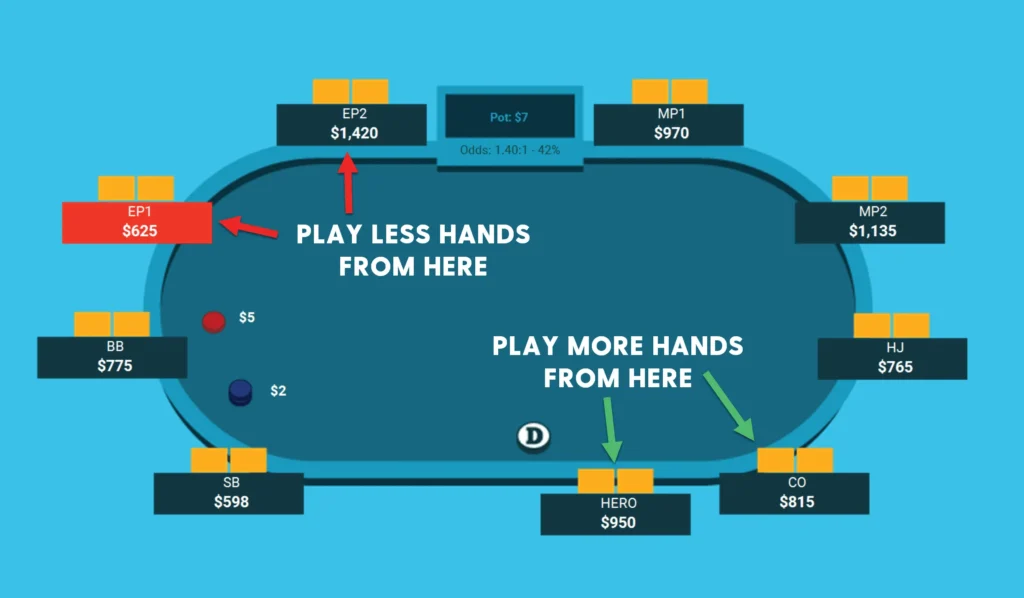Dominating the pre-flop phase is a cornerstone of a winning No-Limit Hold’em strategy. Understanding and mastering a few key mechanics can significantly elevate your game before the first community cards even hit the board. Here are three essential mechanics to focus on for pre-flop poker strategy.

1.Pre-flop Raise First In (RFI) Mechanics
The decision of whether to be the first player to voluntarily put chips into the pot (Raise First In, or RFI) is fundamental, and your position at the table is the most critical factor.
- Position is Power: The later your position, the more frequently you should raise when the action folds to you. Raising from early position means you’re up against the entire table. Conversely, raising from the button pits you against only the small and big blinds, and you’ll have the advantage of acting last post-flop.
- Adjust Your Ranges by Position: Many players make the mistake of playing too loosely in early position and too tightly in late position. The optimal approach is the opposite: tighten up in early position and loosen your raising range in later positions, particularly with deeper stacks. For example, in an 8-handed game with 80 big blind stacks, an early position RFI range is tight, folding hands like 54 suited, Queen8 suited, King Jack offsuit, and Ace9 offsuit. From the button with the same stack depth, you should raise a much wider range, including many suited hands (like 102 suited or 74 suited), all pairs, and various offsuit hands like 87 offsuit or any Ace. A common error is not raising weaker suited and offsuit hands from the button. It’s also crucial to avoid marginal offsuit hands when out of position.
- Stack Depth Adjustments: Your RFI ranges should also adapt to stack depth. For instance, with 25 big blinds on the button, your RFI range should be tighter (46.3%) than with 80 big blinds (55.6%). With shallower stacks, you’ll fold more suited hands and some pairs like pocket twos.
2.Three-Betting Mechanics
Three-betting, which is re-raising an opponent’s initial raise before the flop, is a powerful tool in your pre-flop arsenal. Understanding when and how to three-bet involves choosing between two primary range constructions: linear and polarized.
- Linear Three-Betting Range: This range consists of your best hands along with thin value hands.
- When to Use: Employ a linear range against players who call too often, especially with weaker hands that your three-betting hands dominate. This is particularly effective if your opponents are unlikely to four-bet bluff frequently. Another scenario is when you want to avoid calls altogether, such as from the small blind with deep stacks, due to being out of position and the impact of rake. In such cases, you might three-bet every hand you play, forming a strong range. Linear ranges are also good for exploiting “splashy” players who call with a lot of weak hands.
- Polarized Three-Betting Range: This range includes all your best hands (for value) and some hands from the bottom of your playable range that act as bluffs. Hands that fall between your strongest value hands and your bluffs are typically called.
- When to Use: A polarized range is effective against players who fold too often when you three-bet. If an opponent raises a wide range but then folds frequently to a re-raise, three-betting with many bluffs allows you to gain fold equity. It’s also used in situations where you generally want to have a lot of hands that can call an initial raise. This often occurs when you are in position, which enables you to realize your post-flop advantage. Calling with medium-strength hands, small to medium pairs, and decent suited connectors is part of this strategy. Polarized ranges can exploit tight, straightforward players who won’t punish you with four-bet bluffs or who often fold to a three-bet.
- Stack Depth Impact: When deeper stacked (e.g., 80 big blinds), you tend to include more bluffs in your three-betting range compared to when you are shallower stacked (e.g., 30 big blinds).
3.Pre-flop Tips for Short-Stacked Play
Playing with a shorter stack requires significant adjustments to your pre-flop strategy.
- High Cards are King: When you’re shallower stacked, high cards become vital. Hands like suited connectors, small pairs, and suited Aces decrease significantly in value.
- Reduced Value of Speculative Hands: The worth of speculative hands diminishes because you won’t make flushes and straights as often. Even when you do hit, your opponent will have fewer chips (e.g., 10-20 big blinds) to pay you off compared to when playing with deep stacks (e.g., 200 big blinds). With deep stacks, small pairs and suited Aces are excellent because of their potential to win a large pot when you flop a set or a strong flush.
- Top Pair is a Key Target: When shallow stacked, making top pair and getting your money in is a vital strategy.
- Range Adjustments: As stacks get shorter, your pre-flop ranges will shift to include more high-card hands and fewer drawing hands, both when raising first in and when three-betting. High-card hands like King Jack offsuit are easier to play with a short stack because flopping top pair often allows you to commit your chips easily. Suited connected hands lose considerable value as stacks become shallower.
- Beyond Fold or All-In: Even when you get shallow (e.g., 30 big blinds), your only options aren’t just folding or going all-in. You can still call and three-bet to a non-all-in amount. However, your three-betting frequency, especially with bluffs, will decrease significantly with a shallow stack.
By diligently working on these three mechanics—your raise first in strategy, your approach to three-betting, and your adjustments for short-stacked play—you can build a much stronger and more profitable pre-flop game in No-Limit Hold’em.
